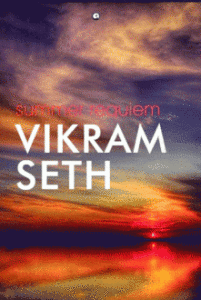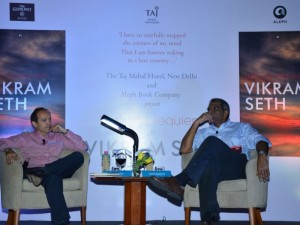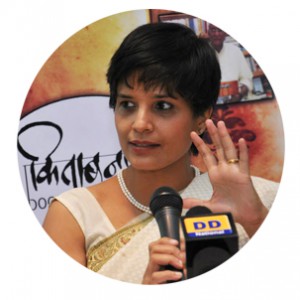Vikram Seth, “Summer Requiem”
 Vikram Seth’s poetry is exquisite. Always was and is. Years ago I recall my mother being handed a copy of The Golden Gate by a friend, a journalist, who had interviewed Seth. Mum received an autographed copy of a paperback edition. It had a boring blue cover with a photograph of the Golden Gate but the excitement about reading a novel in verse by an Indian was far greater than nitpicking about the ordinary production quality of the book. It was the nineteen eighties when Indians were barely recognised globally for writing original fiction and poetry in English. Literary discussions were still confined to the legacies of R. K. Narayan, Raja Rao and the emerging “St Stephens School of Writing” to which male writers such as Amitav Ghosh, Shashi Tharoor, Rukun Advani and Mukul Kesavan belonged. Arundhati Roy’s Booker success with her debut novel, The God of Small Things, was still a few years away. Since then Vikram Seth, his aforementioned contemporaries and a handful of others have been elevated to the literary elite of the subcontinent and for good reason too — their creative ingenuity in making literature that is a pure delight to immerse oneself in for its craft and its gravitas.
Vikram Seth’s poetry is exquisite. Always was and is. Years ago I recall my mother being handed a copy of The Golden Gate by a friend, a journalist, who had interviewed Seth. Mum received an autographed copy of a paperback edition. It had a boring blue cover with a photograph of the Golden Gate but the excitement about reading a novel in verse by an Indian was far greater than nitpicking about the ordinary production quality of the book. It was the nineteen eighties when Indians were barely recognised globally for writing original fiction and poetry in English. Literary discussions were still confined to the legacies of R. K. Narayan, Raja Rao and the emerging “St Stephens School of Writing” to which male writers such as Amitav Ghosh, Shashi Tharoor, Rukun Advani and Mukul Kesavan belonged. Arundhati Roy’s Booker success with her debut novel, The God of Small Things, was still a few years away. Since then Vikram Seth, his aforementioned contemporaries and a handful of others have been elevated to the literary elite of the subcontinent and for good reason too — their creative ingenuity in making literature that is a pure delight to immerse oneself in for its craft and its gravitas.
Vikram Seth’s new collection of poetry Summer Requiem validates his status as being a well-deserved member of  this exclusive club of writers. In this slim offering of poems published by Aleph Books Vikram Seth experiments with the poetic form. Try scanning the lines and you will be constantly surprised by what you glean. From the traditional form to blank verse of the title poem to translations of poems to creating an extraordinary sonnet in No Further War. The latter poem is not only technically sound but is absorbing to read for its devastating critique of modern day politicians who create mayhem with war, destroying Nature and the beauty of earth, leaving artists a wasteland. In this collection of poems Vikram Seth touches upon a range of issues — commentary, reflecting upon his own body of work including working on a novel ( a reference perhaps to the work-in-progress A Suitable Girl? ), engaging in literary criticism such as discussing the importance of translations and discovering new writers. Coincidentally when I was reading Summer Requiem I had T. S. Eliot reciting The Wasteland in the background. ( Here is the link: http://www.openculture.com/2009/11/ts_eliot_reads_the_wasteland.html ) . It is a powerful experience. Two poets, writing decades apart, commenting on the deeply disturbing man-made catastrophes. A couple of toxic madmen sting mankind. (Vikram Seth “No Further War”) .
this exclusive club of writers. In this slim offering of poems published by Aleph Books Vikram Seth experiments with the poetic form. Try scanning the lines and you will be constantly surprised by what you glean. From the traditional form to blank verse of the title poem to translations of poems to creating an extraordinary sonnet in No Further War. The latter poem is not only technically sound but is absorbing to read for its devastating critique of modern day politicians who create mayhem with war, destroying Nature and the beauty of earth, leaving artists a wasteland. In this collection of poems Vikram Seth touches upon a range of issues — commentary, reflecting upon his own body of work including working on a novel ( a reference perhaps to the work-in-progress A Suitable Girl? ), engaging in literary criticism such as discussing the importance of translations and discovering new writers. Coincidentally when I was reading Summer Requiem I had T. S. Eliot reciting The Wasteland in the background. ( Here is the link: http://www.openculture.com/2009/11/ts_eliot_reads_the_wasteland.html ) . It is a powerful experience. Two poets, writing decades apart, commenting on the deeply disturbing man-made catastrophes. A couple of toxic madmen sting mankind. (Vikram Seth “No Further War”) .
With the permission of Aleph Book Company, I am reproducing some lines of poetry from Vikram Seth’s new collection Summer Requiem.
The liberated generation lives a restrained youth.
…
Memory is a poison; it has sickened my body.
The cleavage of attachment has frayed my mind.
( Summer Requiem)
Abstractions have their place, the concrete too.
(A Cryptic Reply)
Two oval portraits, prints in black and white,
Lean on a shelf; one of them, Pushkin, who
Never stepped out of Russia in his life,
Let alone roamed around this town, but who
Belongs to you who know his works by heart
And, yes, to me, who, though I cannot read
A word of his by eye, know him by soul.
I wouldn’t be here, we’re it not for him.
He gave me me….
…
Translation though it was, though every Russian
Yes, you included, when I met you first,
Before the concert in that cavernous room
Shakes her head slowly when I mention this
In wistful sympathy ( ‘What can they get
From Pushkin who can’t understand our tongue?’),
Yet what I got, I got — and it got me
Out of myself, into myself, and made me
Set everything aside I’d set my thoughts on,
And grasp my time, live in his rooms and write
What even today puzzles me by its birth,
The Golden Gate, that sad and happy thing,
Child of my youth, my first wild fictive fling.
(In a Small Garden in Venice)
Vikram Seth Summer Requiem Aleph Book Company, New Delhi, 2015. Hb. pp.66. Rs 399






